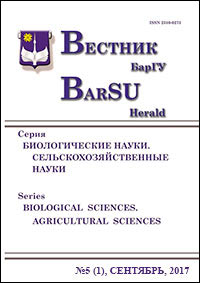APPLICATION OF SAPONITE-CONTAINING BASALTIC TUFFSIN THE CULTIVATION OF VEGETABLE CROPS
Keywords:
saponite-containing basaltic tuff; sod-podzolic sandy loamy soil; magnesium; green beans; basilAbstract
Saponite-containing basaltic tuffs, given their mineralogical and chemical composition, are prospective silicate raw materials in industry. They can also be used as broad spectrum ameliorant in agrobiocenosis, natural sorbent of heavy metals and radionuclides as well as for neutralization and deferrization of water.
The paper presents the results of research on the effectiveness of application of saponite-containing basaltic tuffs in the cultivation of green beans (Phaseolus vulgaris L.) and basil (Ocimum basilicum L.) on sod-podzolic sandy
loamy soil with an average content of exchangeable magnesium (110—120 mg / kg of soil).
Pre-plant application of saponite-containing basaltic tuffs in Mg doses of Mg20–80 increased yield of green beans by 14.2—16.2 dt / ha, green mass of basil — by 0.18—0.24 kg / m2 with better agronomic efficiency in case of application of Mg40 (green beans) and Mg20 (basil) against the background of complete mineral fertilizing.
Table 2. Ref.: 17 titles.
Downloads
Published
Issue
Section
License
Copyright (c) 2023 Вестник БарГУ Серия "Биологические науки. Сельскохозяйственные науки"
Это произведение доступно по лицензии Creative Commons «Attribution-NonCommercial» («Атрибуция — Некоммерческое использование») 4.0 Всемирная.
Авторы сохраняют за собой право заключать определенные договорные соглашения, касающиеся неисключительного распространения опубликованной версии работы (например, размещать ее в институциональном репозитории, публикация в книге) со ссылкой на ее первоначальную публикацию в этом журнале.





